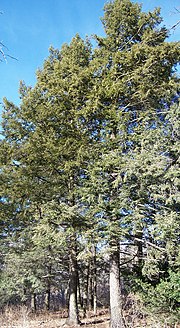Tsuga canadensis
| Tsuga canadensis subsp. var. | Canadian hemlock, Eastern hemlock | |||||||||||||||||||||||||||||||||||||||||||||||||||||||
|---|---|---|---|---|---|---|---|---|---|---|---|---|---|---|---|---|---|---|---|---|---|---|---|---|---|---|---|---|---|---|---|---|---|---|---|---|---|---|---|---|---|---|---|---|---|---|---|---|---|---|---|---|---|---|---|---|

|
|
| ||||||||||||||||||||||||||||||||||||||||||||||||||||||
| ||||||||||||||||||||||||||||||||||||||||||||||||||||||||
Tsuga canadensis, also known as Eastern or Canadian Hemlock, and in the French-speaking regions of Canada as Pruche du Canada, is a coniferous tree native to eastern North America. It ranges from northeastern Minnesota eastward through southern Quebec to Nova Scotia, and south in the Appalachian Mountains to northern Georgia and Alabama. Scattered outlier populations occur in several areas east and west of the Appalachians. It is the state tree of Pennsylvania.[1]
The eastern hemlock grows well in shade and is very long lived with the oldest recorded specimen being at least 554 years old.[2] The tree generally reaches heights of about 31 metres (100 feet),[1] but exceptional trees have been recorded up to 53 metres (173 feet).[3] The diameter of the trunk at breast height is often 1.5 metres (5 feet), but again, outstanding trees have been recorded up to 1.75 meters (6 feet).[4] The trunk is usually straight and monopodial, but very rarely is forked.[5] The crown is broadly conic, while the brownish bark is scaly and deeply fissured, especially with age.[1] The twigs are a yellow-brown in colour with darker red-brown pulvini, and are densely pubescent. The buds are ovoid in shape and are very small, measuring only 1.5 to 2.5 mm (0.05 to 0.1 inches) in length. These are usually not resinous, but may be slightly so.[1][5]
The leaves are typically 15 to 20 mm (0.6 to 0.9 inches) in length, but may be a short as 5 mm (0.2 inches) or as long as 25 mm (1 inch). They are flattened and are typically distichous, or two-ranked. The abaxial surface of the leaf, or underside, is glaucous with 2 broad and clearly visible stomatal bands, while the adaxial surface, i.e. the upper-side, is a shiny green to yellow-green in colour. The leaf margins are very slightly dentate, or toothed, especially near the apex. The seed cones are ovoid in shape and typically measure 1.5 to 2.5 cm (0.6 to 1 inch) in length and 1 to 1.5 cm (0.4 to 0.6 inches) in width. The scales are ovate to cuneate in shape and measure 8 to 12 mm (0.3 to 0.5 inches) in length by 7 to 10 mm (0.3 to 0.4 inches) in width. The apex is more or less rounded and is often projected outward. 24 diploid chromosomes are present within the tree's DNA.[1][5]
| Standard Cyclopedia of Horticulture |
|---|
|
Tsuga canadensis, Carr. (Abies canadensis, Michx.). Common Hemlock. Tree, attaining 70 and occasionally 100 ft.: young branchlets yellowish brown, pubescent: lvs. linear, obtuse or acutish, dark green and obscurely grooved above, with 2 whitish lines beneath, 1/4 – 2/3 in. long: cones ovoid, 1/2 – 3/4 in. long, peduncled; scales almost orbicular. New Bruns. and Wis., south to Ala.—The hemlock spruce yields the lumber most commonly used in the E. for framing and clap-boarding of buildings. It is not used for finishing lumber. A number of garden forms have been raised; the following are the most important: Var. albo-spica, Nichols. Tips of the young branchlets creamy white. Var. compacta, Senecl. (var. compacta nana, Beissn.). Dwarf conical pyramid with numerous short branchlets clothed with small lvs. Var. globosa, Beissn. (var. globularis erecta, Kunkler). Dense, globose, much-branched form with numerous upright branches nodding at the ends. Var. gracilis, Gord. (var. microphylla, Hort.). Slow-growing form with slender sparingly ramified branches, spreading and more or less drooping at the ends: lvs. very small, about 1/4 in. long. Var. nana, Carr. Dwarf and depressed form with spreading branches and short branchlets. Var. parvifolia, Veitch. Lvs. very small, 1/4 in. long or shorter: branchlets stout, closely set and numerous. Var. pendula, Parsons (var. Sargentii pendula, Hort., var. Sargentiana, Kent). Flat-topped form with spreading branches and drooping branchlets. Very distinct and desirable form. CH
|
Cultivation
- Do you have cultivation info on this plant? Edit this section!
Propagation
- Do you have propagation info on this plant? Edit this section!
Pests and diseases
- Do you have pest and disease info on this plant? Edit this section!
Species
Gallery
References
- Standard Cyclopedia of Horticulture, by L. H. Bailey, MacMillan Co., 1963
External links
- w:Tsuga canadensis. Some of the material on this page may be from Wikipedia, under the Creative Commons license.
- Tsuga canadensis QR Code (Size 50, 100, 200, 500)
Cite error:
<ref> tags exist, but no <references/> tag was found

